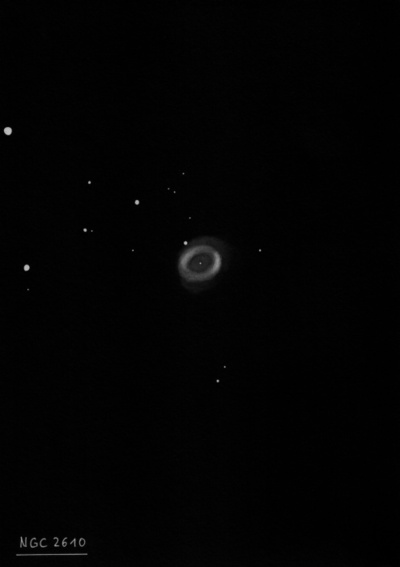
William Herschel discovered NGC 2610 = H IV-35 = h513 = 3127 on 31 Dec 1785 (sweep 503) and recorded "a small star with an electrical brush sp; F; S. About 1 1/2' after follows a star of the 8th magnitude. It resembles fig 7, Phil. Trans. Vol LXXIV.Tab.17. [Plate VII]". Herschel commented in his 1814 PT paper that "a small star has a small, faint, fan-shaped nebulosity joining to it on the north preceding side." He used this example to (incorrectly) demonstrate the union or mutual attraction between the objects. On 16 Nov 1827 (sweep 111), John Herschel wrote, "A * 14m with a fan-shaped brush 15" l to the sp side; the brush however judged by both Mr. [James?] Dunlop (who saw it) and myself not to be in contact." The 1 Feb 1851 observation by Lord Rosse reads "Dark space foll star, bet neb and star stronlgly suspected like the "snow-drop nebula" [NGC 2261]. Lord Rosse suspected a star in it also."
In 1915, Harold Knox-Shaw reported this object was annular and the spectrum probably gaseous based on a photograph with the Reynolds reflector at the Helwan Observatory. The spectrum was confirmed by Campbell and Paddock at Lick. Based on Crossley photographs at Lick, Curtis (1918) reported "the ring is slightly irregular, hazy and without structural detail; is 38"x31" in pa 75°. Relatively vacant around the central. The matter in the ring is rather faint."
300/350mm - 13.1" (1/18/85): moderately bright PN, fairly small, slightly elongated ~N-S, about 40" diameter. No annularity or central star seen. A mag 13 star is at the NE edge. Located 3.5' SW of mag 6.6 SAO 154395.
400/500mm - 17.5" (3/25/00): at 280x using a UHC filter appears moderately bright, ~45"x40", elongated SSW-NNE. A mag 12 star is embedded on the NE edge of the rim. The planetary appears to taper near the star although this may be a contrast effect. The rim is sharp-edged and the surface brightness pretty smooth. Located 3.5' SW of a mag 6.5 star.
900/1200mm - 48" (2/28/19 and 3/1/19): at 488x and 813x; bright, fairly large, roundish, 50" diameter. Contains a thick brighter rim (about half the diameter) with a darker central hole. The rim is slightly brighter in a 90° arc centered on the NW side and appears slightly irregular or ragged around the periphery. The rim was slightly weaker just south of a prominent 12th magnitude star on the NE edge. The faint central star was easily visible. With a NPB filter there was a thin outer halo. Located 3.5' SW of a mag 6.6 HD 72665.
Notes by Steve Gottlieb